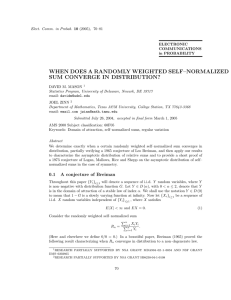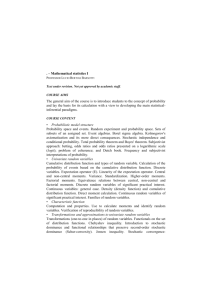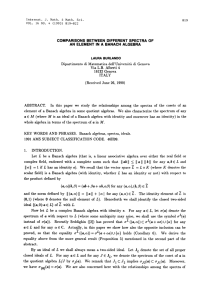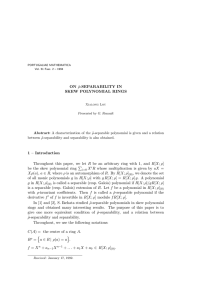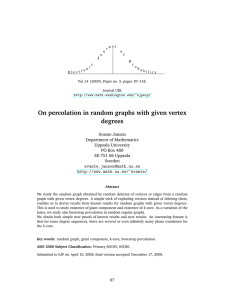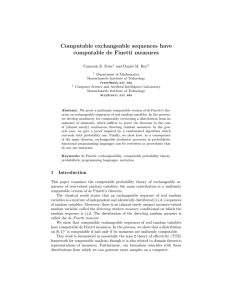STABILITY FOR RANDOMLY WEIGHTED SUMS OF RANDOM ELEMENTS
advertisement
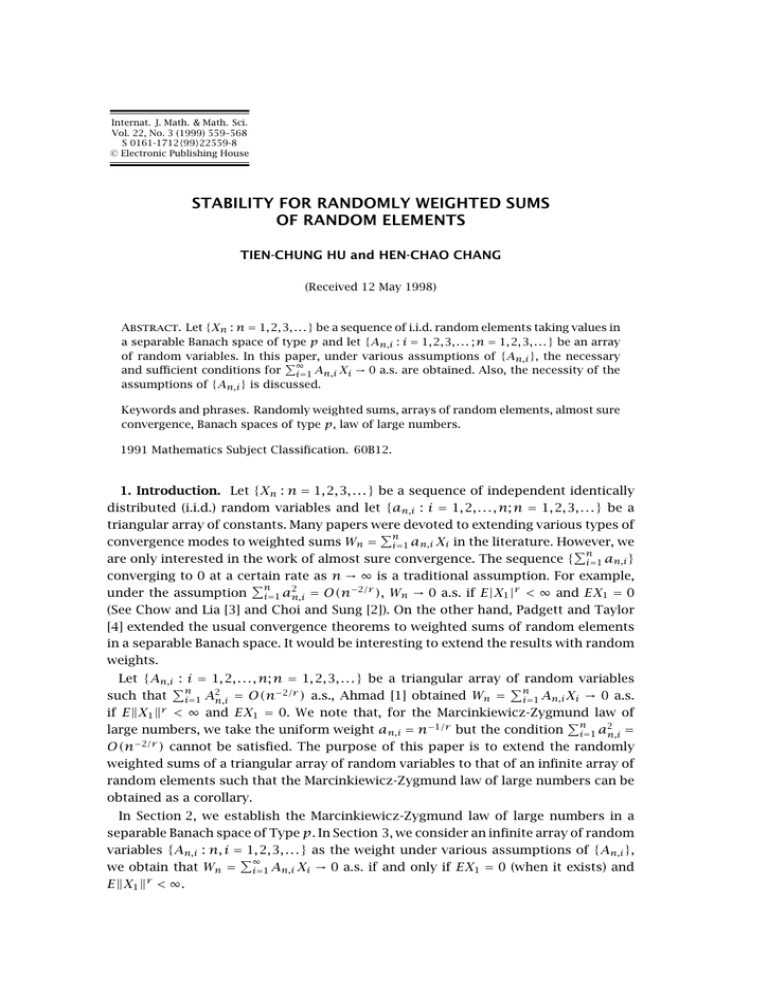
Internat. J. Math. & Math. Sci.
Vol. 22, No. 3 (1999) 559–568
S 0161-17129922559-8
© Electronic Publishing House
STABILITY FOR RANDOMLY WEIGHTED SUMS
OF RANDOM ELEMENTS
TIEN-CHUNG HU and HEN-CHAO CHANG
(Received 12 May 1998)
Abstract. Let {Xn : n = 1, 2, 3, . . . } be a sequence of i.i.d. random elements taking values in
a separable Banach space of type p and let {An,i : i = 1, 2, 3, . . . ; n = 1, 2, 3, . . . } be an array
of random variables. In this paper, under various assumptions of {An,i }, the necessary
and sufficient conditions for ∞
i=1 An,i Xi → 0 a.s. are obtained. Also, the necessity of the
assumptions of {An,i } is discussed.
Keywords and phrases. Randomly weighted sums, arrays of random elements, almost sure
convergence, Banach spaces of type p, law of large numbers.
1991 Mathematics Subject Classification. 60B12.
1. Introduction. Let {Xn : n = 1, 2, 3, . . . } be a sequence of independent identically
distributed (i.i.d.) random variables and let {an,i : i = 1, 2, . . . , n; n = 1, 2, 3, . . . } be a
triangular array of constants. Many papers were devoted to extending various types of
n
convergence modes to weighted sums Wn = i=1 an,i Xi in the literature. However, we
n
are only interested in the work of almost sure convergence. The sequence { i=1 an,i }
converging to 0 at a certain rate as n → ∞ is a traditional assumption. For example,
n
under the assumption i=1 a2n,i = O(n−2/r ), Wn → 0 a.s. if E|X1 |r < ∞ and EX1 = 0
(See Chow and Lia [3] and Choi and Sung [2]). On the other hand, Padgett and Taylor
[4] extended the usual convergence theorems to weighted sums of random elements
in a separable Banach space. It would be interesting to extend the results with random
weights.
Let {An,i : i = 1, 2, . . . , n; n = 1, 2, 3, . . . } be a triangular array of random variables
n
n
such that i=1 A2n,i = O(n−2/r ) a.s., Ahmad [1] obtained Wn = i=1 An,i Xi → 0 a.s.
if E
X1 r < ∞ and EX1 = 0. We note that, for the Marcinkiewicz-Zygmund law of
n
large numbers, we take the uniform weight an,i = n−1/r but the condition i=1 a2n,i =
O(n−2/r ) cannot be satisfied. The purpose of this paper is to extend the randomly
weighted sums of a triangular array of random variables to that of an infinite array of
random elements such that the Marcinkiewicz-Zygmund law of large numbers can be
obtained as a corollary.
In Section 2, we establish the Marcinkiewicz-Zygmund law of large numbers in a
separable Banach space of Type p. In Section 3, we consider an infinite array of random
variables {An,i : n, i = 1, 2, 3, . . . } as the weight under various assumptions of {An,i },
∞
we obtain that Wn = i=1 An,i Xi → 0 a.s. if and only if EX1 = 0 (when it exists) and
E
X1 r < ∞.
560
T.-C. HU AND H.-C. CHANG
2. The Marcinkiewicz law in a space of type p. Let (Ω, F , P ) be a probability space
and B be a real separable Banach space with norm • . A random element is defined
to be an F -measurable mapping of Ω into B with the Borel σ -field. The concept of
independent random elements is a direct extension of the concept of independent
random variables. A detailed account of basic properties of random elements in real
Banach spaces can be found in Taylor [6].
In this section, we prove the Marcinkiewicz-Zygmund law of large numbers in a space
of type p. First, we introduce a space of type p.
Definition 1. Let 1 ≤ p ≤ 2 and {ri : i = 1, 2, 3, . . . } be a sequence of independent
random variables with Pr(ri = ±1) = 1/2. A separable Banach space B is said to be of
type p if there exists a constant C such that
1/p
n
n
p
ri xi ≤ C
xi E
i=1
(2.1)
i=1
for every n ∈ N and all x1 , . . . , xn ∈ B.
Woyczyński [7] proved the equivalent condition of a space of type p.
Lemma 1 (Woyczyński [7]). Let 1 ≤ p ≤ 2 and q ≥ 1. The following properties of B
are equivalent :
(i) The separable Banach space B is of type p.
(ii) There exists C such that, for every n ∈ N and for any sequence {Xi : i = 1, 2, . . . , n}
of independent random elements in B with EXi = 0, i = 1, 2, . . . , n,
q/p
n
n
q
Xi p
E Xi (2.2)
.
≤ CE
i=1
i=1
Using Lemma 1, some elementary properties of spaces of type p can be easily proved.
Every separable Hilbert space and finite-dimensional Banach space are of type 2. Every
separable Banach space is at least of type 1, and the p and Lp are of type min{2, p}
for p ≥ 1. If B is a space of type p and 1 ≤ q ≤ p, then B is a space of type q. Before
considering the Marcinkiewicz-Zygmund law of large numbers in a space of type p,
we need the following definition and lemmas.
Definition 2. Let B be a separable Banach space, B∗ the dual space of B, and B
the unit ball in B∗ . X is a random element in B. The directionally maximum median of
X is defined by
ρ(X) ≡ sup µ f (X) ,
f ∈B
(2.3)
where µ(Y ) denotes the minimum median in absolute value of the random variable Y .
Lemma 2 (Sakhanenko [5]). Let X1 , . . . , Xn be independent random elements in B and
k
Sk = i=1 Xi , then, for every t > 0,
Pr max Sk > t ≤ 2 Pr Sn > t − max ρ Sn − Sk .
(2.4)
1≤k≤n
1≤k≤n
STABILITY FOR RANDOMLY WEIGHTED SUMS . . .
561
Lemma 3. Let {Xn : n = 1, 2, 3, . . . } be a sequence of independent random elements
n
in a separable Banach space. If Sn = i=1 Xi converges to a random element S in
probability, then Sn converges to S a.s.
Proof. Since Sn converges to S in probability, take " such that 0 < " < 1/2, then
there exists an integer n0 such that if m > n ≥ n0 ,
"
"
"
"
<
and
Pr Sn − S >
< .
(2.5)
Pr Sm − S >
2
2
2
2
So,
"
"
1
Pr Sm − Sn > " < Pr Sm − S >
+ Pr Sn − S >
<"< .
2
2
2
(2.6)
We have µ(
Sm − Sn ) < " for any m > n ≤ n0 , where µ(Y ) is minimum median in
absolute value of the random variable Y .
By Lemma 2, if m1 > n > n0 ,
Pr
max Sm − Sn > 2" ≤ 2 Pr Sm1 − Sn > 2" − max ρ Sm1 − Sm
n<m<m1
n<m<m1
(2.7)
≤ 2 Pr Sm1 − Sn > 2" − max µ Sm1 − Sm n<m<m1
≤ 2 Pr Sm1 − Sn > " < 2".
Let m1 → ∞, then if m > n > n0 , we have Pr(maxn<m Sm − Sn > 2") < 2".
We obtain Sn converges to some random element a.s., and Sn converges to S in
probability. Hence, Sn converges to S a.s.
Now, we prove the Marcinkiewicz-Zygmund law of large numbers in a space of
type p.
Theorem 1. Let B be a separable Banach space of type P and {Xn : n = 1, 2, 3, . . . }
be a sequence of independent and identically distributed random elements in B. Then,
for any 0 < r < p,
Sn − nc
→ 0
n1/r
a.s.
(2.8)
for some constant c if and only if E
X1 r < ∞.
Moreover, if r ≥ 1, c = EX1 and 0 < r < 1, c is arbitrary.
Proof.
Necessary part. Since (2.8) holds,
Sn − nc
n − 1 1/r Sn−1 − nc
Xn
=
−
→ 0 a.s.,
(2.9)
n1/r
n1/r
n
(n − 1)1/r
∞
whence, by the Borel-Cantelli lemma, n=1 Pr(
X1 > n1/r ) < ∞. Thus, E
X1 r < ∞.
Sufficient part. Since E
X1 r < ∞, define Yn = n−1/r Xn I(
Xn ≤ n1/r ) and Aj =
{(j −1)1/r < X1 ≤ j 1/r }. Choose a positive number α such that r < α ≤ p and α ≥ 1.
We have
n
∞
∞
∞ ∞ E
Yn α =
n−α/r
X1 α dp =
n−α/r
X1 α dp
n=1
n=1 j=1
Aj
j=1 n=j
Aj
562
T.-C. HU AND H.-C. CHANG
≤ c1
∞
j 1−α/r
j=1
r
Aj
= c1 E
X1 < ∞,
X1 α dp ≤ c1
∞ j=1
Aj
X1 r dp
(2.10)
for some constant c1 .
From Lemma 1,
α/p
m
m p
α
Yi − EYi
E
Yi − EYi ≤ c2 E
i=n
i=n
m
m
α
α
≤ c2
E Yi − EYi ≤ 2α c2
E Yi .
i=n
(2.11)
i=n
n
We have i=1 (Yi − EYi ) converges to some random element Y0 in Lα . Therefore,
n
n
i=1 (Yi − EYi ) → Y0 in probability. By Lemma 3,
i=1 (Yi − EYi ) → Y0 a.s. Since
∞
Pr
n=1
∞
Xn
≠
Y
Pr X1 > n1/r ≤ E
X1 r < ∞,
=
n
n1/r
n=1
(2.12)
so,
∞
∞ Xn − E Xn I Xn ≤ n1/r
Xn
=
−
EY
n
n1/r
n1/r
n=1
n=1
converges a.s.
(2.13)
∞
∞
If 0 < r < 1, we can choose α = 1. Then n=1 E
Yn < ∞. We have n=1 (Xn )/(n1/r )
converges a.s. By Kronecker lemma, (Sn −nc)/(n1/r ) converges a.s. for any constant c.
n
If r = 1, by Kronecker lemma, (Sn /n) − (1/n) i=1 E(Xi I(
Xi ≤ n)) converges a.s.
and E(Xn I(
Xn ≤ n)) → EX1 , we have (2.8) holds.
If r > 1, we can show that
∞
n−1/r E Xn I Xn > n1/r ∞ ∞
∞
n=1
≤
n−1/r E X1 I X1 > n1/r =
n−1/r
n=1
=
n=1
∞ j−1
n−1/r
j=2 n=1
≤
Therefore,
lemma.
∞
∞
r
r − 1 j=1
n=1 (Xn
Aj
Aj
X1 dp ≤
X1 r dp =
j=n+1
Aj
X1 dp
∞
r (j − 1)(r −1)/r
X1 dp
r − 1 j=1
Aj
(2.14)
r
E
X1 r < ∞.
r −1
− EX1 )/n1/r converges a.s. We have (2.8) holds by Kronecker
3. The convergence of the weighted sums. Throughout this section, we deal with
∞
the almost sure convergence of randomly weighted sums i=1 An,i Xi , where {Xn :
n = 1, 2, 3, . . . } is a sequence of independent and identically distributed random elements in a space of type p and {An,i : n, i = 1, 2, 3, . . . } is an array of random variables
satisfying some conditions.
STABILITY FOR RANDOMLY WEIGHTED SUMS . . .
563
Theorem 2. Let B be a separable Banach space of type p. Let {Xn : n = 1, 2, 3, . . . } be
a sequence of independent and identically distributed random elements in B such that
E
X1 r < ∞ and r < p. Moreover, we assume that EX1 = 0 when r ≥ 1. Let {An,i : n, i =
1, 2, 3, . . . } be an array of random variables such that {An,i } and {Xi } are independent
and satisfying
a.s. for every n,
(3.1)
An,i = O i−1/r
lim An,i = 0
a.s. for every i,
n→∞
∞
r
E An,i < ∞
and
(3.2)
for every n,
(3.3)
i=1
∞
i1/r An,i − An,i+1 < M
a.s. for every n and some constant M > 0.
(3.4)
i=1
Then
lim
n→∞
Conversely, if
lim
n→∞
∞
An,i Xi = 0
a.s.
(3.5)
An,i Xi = 0
a.s.
(3.6)
i=1
∞
i=1
for all arrays {An,i } satisfying the above conditions, then E
X1 r < ∞.
Proof. Since {An,i } and {Xi } are independent, if r > 1, we choose p = q = r in
Lemma 1, then
r
∞
∞
E|An,i |r E
X1 r < ∞.
(3.7)
E An,i Xi ≤
i=1
i=1
If r ≤ 1, it is obvious that
r
∞
∞
E|An,i |r E
X1 r < ∞.
E An,i Xi ≤
i=1
(3.8)
i=1
∞
Therefore, i=1 An,i Xi converges a.s.
−
Since An,i = A+
n,i − An,i , without loss of generality, we can assume that An,i ≥ 0.
k
Let Sk = i=1 Xi , Yk = (Sk /k1/r ) for every k ≥ 1 and S0 = 0. By Theorem 1, we have
limk→∞ Yk = 0 a.s.
∞
∞
N−1
An,i Xi =
An,i Si − Si−1 = lim
An,i − An,i+1 Si + An,N SN .
(3.9)
i=1
N→∞
i=1
i−1
Since {i1/r An,i } is bounded a.s. for every n and r ,
lim An, N SN = lim N 1/r An, N YN = 0
N→∞
N→∞
a.s.
(3.10)
We have
∞
i=1
An,i Xi =
∞
i=1
i1/r An,i − An,i+1 Yi
a.s.
(3.11)
564
T.-C. HU AND H.-C. CHANG
∞
Let Bn,i = i1/r (An,i −An,i+1 ). Hence, i=1 |Bn,i | ≤ M a.s. for every n and limn→∞ Bn,i = 0
∞
1
= w : i=1 |Bn,i (w)| ≤ M
a.s. for every i. Define D 0 = {w : limi→∞ Yi (w) = 0} and Dn
∞
for each n and Di2 = {w : limn→∞ Bn,i (w) = 0} for each i. For every w ∈ D 0 ∩ i=1 (Di1 ∩
2
Di ) and every " > 0, we can choose A such that Yi (w)
< " for i ≥ A,
∞
Bn,i (w)Yi (w)
≤
i=1
A−1
|Bn,i (w)|
Yi (w)
+
i=1
i≤A−1
1
2
i=1 (Di ∩ Di ))
n→∞
A−1
(3.12)
|Bn,i (w)| + M" → M"
as n → ∞.
i=1
∞
lim
|Bn,i (w)|
Yi (w)
i=A
≤ max Yi (w)
Since Pr(D 0 ∩
∞
∞
= 1, limn→∞
An,i Xi = lim
∞
n→∞
i=1
i=1 Bn,i Yi ∞
Bn,i Yi = 0
= 0 a.s. Therefore,
a.s.
(3.13)
i=1
∞
If limn→∞ i=1 An,i Xi = 0 a.s. for all arrays {An,i } satisfying the above conditions,
we can choose
n−1/r if i ≤ n,
(3.14)
An,i =
0
if i > n.
Then (2.8) holds. By Theorem 1, we have E
X1 r < ∞.
Remark 1. The following example claims that condition (3.4) cannot be omitted.
Consider the real number space R as a space of type 2. Choose a sequence {Xn : n =
1, 2, 3, . . . } of independent and identically distributed random variables with EX12 < ∞
and EX1 = 0. Define
n−1/2 if i ≤ n,
(3.15)
An,i =
0
if i > n.
Choose any r < 2 so that condition (3.4) does not hold. By the Central Limit Theorem,
∞
i=1 An,i Xi cannot converge to 0 a.s.
∞
Choi and Sung [2] considered the almost sure convergence of
i=1 an,i Xi for
triangular array of constants. Their Theorem 3 can be regarded as a corollary of
Theorem 2.
Corollary 1 (Choi and Sung [2, Theorem 3]). Let {Xn : n = 1, 2, 3, . . . } be independent and identically distributed random variables with EX1 = 0 and E|X1 |r < ∞ for
some 1 ≤ r < 2. Let {an,i : i = 1, 2, . . . , n; n = 1, 2, 3, . . . } be a triangular array of conn
stants satisfying i=1 |an,i − an,i+1 | = O(n−1/r ), where an,n+1 = 0. Then
lim
n→∞
n
an,i Xi = 0
a.s.
(3.16)
i=1
Proof. By Theorem 2, we must show that there is a constant M > 0 such that
lim an,i = 0
n→∞
for every i
(3.17)
STABILITY FOR RANDOMLY WEIGHTED SUMS . . .
565
and
∞
i1/r |an,i − an,i+1 | < M
for every n.
(3.18)
i=1
n
There is a constant C > 0 such that i=1 |an,i − an,i+1 | ≤ Cn−1/r . We have |an,i | ≤
Cn−1/r for every i. So, limn→∞ an,i = 0 for every i.
Therefore,
∞
i1/r |an,i − an,i+1 | =
i=1
n
i1/r |an,i − an,i+1 |
i=1
≤ n1/r
n
(3.19)
|an,i − an,i+1 | ≤ C.
i=1
So, the proof is complete.
The assumptions of {An,i } in Theorem 2 can be simplified as in Theorem 3 for r < 1
and Theorem 4 for r ≥ 1.
∞
Lemma 4. Let {bn : n = 1, 2, 3, . . . } be a sequence of positive numbers. If i=1 i|bi −
∞
bi+1 | < ∞ and i=1 bi < ∞, then there exists C > 0 such that ibi < C for all i.
∞
∞
Proof. Since i=1 i|bi −bi+1 | < ∞, there exists N > 0 such that k=N i|bi −bi+1 | <
1. If the result of this Lemma is false, then any n, l > 0, there exists i > l such that
bi > n/i. We define
J
if j ≥ 2.
(3.20)
ni ≡ inf i : i > 2nj−1 and bi >
i
And
1
.
n1 ≡ inf i : i > N and bi >
i
n0 ≡ 0,
(3.21)
We see that
∞
bi =
i=1
∞
ni
bk =
i=1 k=ni−1 +1
∞
ni
i=1 k=ni−1 +1
bni + bk − bni .
(3.22)
If m > n ≥ N, then
m
bi − bm ≤
i=n
m m−1
|bk − bk+1 | =
i=n k=i
k
m−1
|bk − bk+1 | ≤
k=n i=n
m−1
K|bk − bk+1 | < 1.
(3.23)
k=n
Therefore,
∞
i=1
But
∞
i=1 bi
bi =
∞
ni
i=1 k=ni−1 +i
bni + bk − bni
∞ ∞ ni
i i
≥
− 1 = ∞.
×
ni − ni−1 − 1 ≥
ni
ni
2
i=2
i=2
< ∞ and the proof is complete.
When r < 1, Theorem 2 can be rewritten as follows.
(3.24)
566
T.-C. HU AND H.-C. CHANG
Theorem 3. Let B be a separable Banach space of type p. Let {Xn : n = 1, 2, 3, . . . }
be a sequence of independent and identically distributed random elements in B such
that E
X1 r < ∞ and r < 1. Let {An,i : n, i = 1, 2, 3, . . . } be an array of random variables
such that {An,i } and {Xi } are independent, and satisfying
lim An,i = 0 a.s. for every i,
(3.25)
n→∞
∞
E|An,i |r < ∞
a.s. for every n,
(3.26)
i=1
and
∞
i|An,i − An,i+1 |r < M
a.s. for every n and some constant M > 0.
(3.27)
i=1
∞
Then limn→∞ i=1 An,i Xi = 0 a.s.
∞
Conversely, if limn→∞ i=1 An,i Xi = 0 a.s. for all arrays {An,i } satisfying the above
conditions, then E
X1 r < ∞.
−
generality, we can assume that
Proof. Since An,i = A+
n,i − An,i , without loss of
∞
∞
r
An,i ≥ 0. We consider An,i = bi in Lemma 4. Since i=1 i|Arn,i − Arn,i+1 | ≤ i=1 i|An,i −
An,i+1 |r , for r < 1, we have An,i = O(i−1/r ) a.s. for every n. From the proof of Theorem
∞
∞
2, we have limi→∞ Yi = 0 a.s. and i=1 An,i Xi = i=1 i1/r (An,i − An,i+1 )Yi a.s., where
i
Yi = (1/i1/r ) j=1 Xj .
∞
Define Bn,i = i1/r (An,i − An,i+1 ). Hence, i=1 |Bn,i |r ≤ M a.s. and limn→∞ Bn,i = 0 a.s.
∞
Let D = D 0 ∩ i=1 (Di1 ∩Di2 ), where the definitions of D 0 , Di1 , and Di2 are the same as in
Theorem 2. For every w ∈ D and every " > 0, we can choose A such that Yi (w)
< "
for i ≥ A,
∞
i=1
Bn,i Yi (w)
r ≤
A−1
|Bn,i |r Yi (w)
r +
i=1
|Bn,i |r Yi (w)
r
i=A
r
≤ max Yi (w)
i≤A−1
Since Pr(D) = 1, limn→∞
∞
∞
A−1
|Bn,i | + M" → M"
as n → ∞.
i=1
r
i=1 Bn,i Yi = 0 a.s. Therefore,
lim An,i Xi = lim
n→∞
(3.28)
r
n→∞
∞
Bn,i Yi = 0
a.s.
(3.29)
i=1
The proof of the converse part is the same as the proof of Theorem 2. So the proof
is complete.
When r ≥ 1, we can obtain the following theorem:
Theorem 4. Let B be a separable Banach space of type p. Let {Xn : n = 1, 2, 3, . . . }
be a sequence of independent and identically distributed random elements in B such
that EX1 = 0 and E
X1 r < ∞ for 1 ≤ r < p. Let {An,i : n, i = 1, 2, 3, . . . } be an array of
STABILITY FOR RANDOMLY WEIGHTED SUMS . . .
567
random variables such that {An,i } and {Xi } are independent, and satisfying
lim An,i = 0 a.s. for every i,
n→∞
∞
E|An,i |r < ∞
for every n,
(3.30)
(3.31)
i=1
and
∞
i=1
1/r
i1/r Arn,i − Arn,i+1 <M
a.s. for every n and some constant M > 0.
Then
lim
n→∞
Conversely, if
lim
n→∞
∞
(3.32)
An,i Xi = 0
a.s.
(3.33)
An,i Xi = 0
a.s.
(3.34)
i=1
∞
i=1
for all arrays {An,i } satisfying the above conditions, then E
X1 r < ∞.
Proof. We see that
∞
and
i1/r |An,i − An,i+1 | <
i=1
∞
i=1
∞
i=1
1/r
i1/r Arn,i − Arn,i+1 <M
∞
1/r
i1/r Arn,i − Arn,i+1 < ∞ ⇒
iArn,i − Arn,i+1 < ∞ (since r ≥ 1).
(3.35)
(3.36)
i=1
So, from the proofs of Theorem 2 and Theorem 3, we can obtain this theorem.
Now, we consider a very special case of {An,i }. Let An,i = n−1/r for i = 1, 2, . . . , n
and An,i = 0 for i > n. The assumptions of {An,i } in Theorem 4 can be easily verified.
Therefore, the Marcinkiewicz-Zygmund law of large numbers in a space of type p can
be obtained as the following corollary.
Corollary 2. Let B be a separable Banach space of type p and {Xn : n = 1, 2, 3, . . . }
be a sequence of independent and identically distributed random elements in B with zero
means. For any 1 ≤ r < p, we have if E
X1 r < ∞, then
1/r n
1
Xi → 0 a.s.
(3.37)
n
i=1
Proof. Let An,i = n−1/r for i = 1, 2, . . . , n and An,i = 0 for i > n. Since
lim An,i = lim n−1/r = 0,
n→∞
∞
and
E|An,i |r =
i=1
∞
i=1
n→∞
n
1
= 1,
n
i=1
1/r
i1/r Arn,i − Arn,i+1 = n1/r · n−1/r = 1,
the proof is complete by Theorem 4.
(3.38)
(3.39)
(3.40)
568
T.-C. HU AND H.-C. CHANG
References
[1]
[2]
[3]
[4]
[5]
[6]
[7]
I. A. Ahmad, An almost sure convergence theorem for weighted sum of random elements
in separable Banach spaces with random weights, Sankhyā Ser. A 44 (1982), no. 2,
262–268. MR 84c:60010. Zbl 586.60008.
B. D. Choi and S. H. Sung, Almost sure convergence theorems of weighted sums of random variables, Stochastic Anal. Appl. 5 (1987), no. 4, 365–377. MR 88m:60079.
Zbl 633.60049.
Y. S. Chow and T. L. Lai, Limiting behavior of weighted sums of independent random variables, Ann. Probab. 1 (1973), 810–824. MR 50 5909. Zbl 303.60025.
W. J. Padgett and R. L. Taylor, Convergence of weighted sums of random elements in Banach spaces and Fréchet spaces, Bull. Inst. Math. Acad. Sinica 2 (1974), 389–400,
Collection of articles in celebration of the sixtieth birthday of Ky Fan. MR 50 11360.
Zbl 301.60004.
A. I. Sakhanenko, On Lévy-Kolmogorov Inequalities for Banach-space-valued Random Variables, Theory Probab. Appl. 29 (1984), 830–836.
R. L. Taylor, Stochastic convergence of weighted sums of random elements in linear spaces,
Lecture Notes in Mathematics, vol. 672, Springer-Verlag, Berlin, 1978. MR 80g:60006.
Zbl 443.60004.
W. A. Woyczyński, On Marcinkiewicz-Zygmund laws of large numbers in Banach spaces
and related rates of convergence, Probab. Math. Statist. 1 (1980), no. 2, 117–131.
MR 82i:60026. Zbl 502.60006.
Hu: Department of Mathematics, National Tsing Hua University, Hsinchu, 30043,
Taiwan
Chang: Institute of Mathematics, Academic Sinica, Taipei, 11529, Taiwan
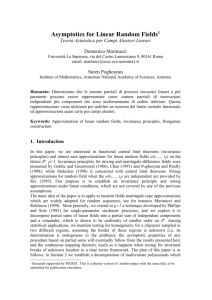
![5.5 The Haar basis is Unconditional in L [0, 1], 1 < 1](http://s2.studylib.net/store/data/010396305_1-450d5558097f626a0645448301e2bb4e-300x300.png)
